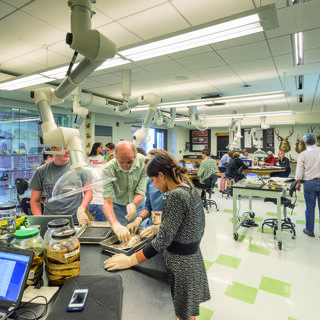Tradeline's industry reports are a must-read resource for those involved in facilities planning and management. Reports include management case studies, current and in-depth project profiles, and editorials on the latest facilities management issues.
Latest Reports
Center for Sciences and Innovation
The 280,000-sf Center for the Sciences and Innovation (CSI) is the largest development ever undertaken on the campus of Trinity University. The phased project includes 150,000 gsf of new construction, an 80,000 gsf gut renovation of Cowles Life Sciences Building, and a light renovation of the 50,000-gsf Marrs McLean Hall, to create an integrated academic complex. It houses teaching and research labs, an engineering studio, greenhouse, vivarium, and an Innovation Studio, and is home to the university-wide Entrepreneurship Center.
Sally and Lawrence Cohen Science Center
The four-story, 72,500-sf Lawrence and Sally Cohen Science Center houses Wilkes University’s departments of Biology and Health Sciences on the second floor; Chemistry and Biochemistry, and Environmental Engineering and Earth Science, on the fourth; teaching labs on the second and fourth floors; and flexible, interdisciplinary research labs on the third. Nearly all Wilkes students will take at least one class in the new facility, which wraps around an existing auditorium on an adjacent building.
Creating an Excel-Based Strategic Facilities Plan
While a traditional space planning document is often outdated as soon as it’s finished, Stanford University’s School of Medicine created its strategic facilities plan as a living document that in minutes can show the impact of even the slightest change in space usage, and can be constantly updated and changed. The medical school spent a year compiling faculty and space needs data into an Excel spreadsheet, and has found the effort well worth the payoffs.
Unlocking Existing Data to Improve Space Utilization
To address space utilization and efficiency, especially in a research environment, the best way to make a case for change is with solid data that makes a compelling link to mission effectiveness, but institutions warehouse vast amounts of data that are often left untapped, says Donn Williams, director of facilities and real estate at RAND Corporation.
Rollins Urban and Structural Entomology Facility
Texas A&M University’s single-story, 10,000-sf Rollins Urban and Structural Entomology Facility features 3,800 sf of research labs for analyzing and maintaining colonies of ants, termites, and cockroaches, and a general insectary for all other insect colonies, such as bed bugs and stored product pests. Specialized spaces include a genetics/analytical lab and an autoclave.




